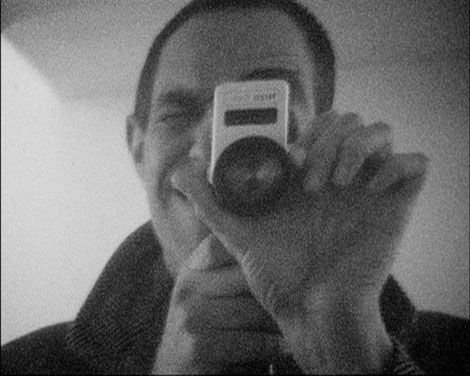“I remember the sea, I remember the garden, I remember the cottage but most of all I remember you… dear Derek… I remember something you once said – how you would like to evaporate and take all your works with you… The truth is, here, over a decade later, in so many ways you never could disappear but – it has to be faced – in so many others… you have.” – Tilda Swinton
“Try explaining to them that I don’t make underground films, I have never made underground films. I hate all the labelling, the boundaries drawn by the ‘communicators’, the middle men who sit between the audience and the experience… It’s a change of heart we’re after not a change of policy; centuries of disinformation don’t go away at the stroke of a pen.” – Derek Jarman
Fade into blue…
In 2008, the BFI released Derek – a meditative, dream-like reminiscence of Derek Jarman written and presented by Tilda Swinton and directed by Isaac Julien. Although formally conservative (which may seem initially strange considering the aesthetic pursuits of both subject and director) Julien constructed a rather magical narrative by letting Jarman recount his biography through his own footage, words and interviews. Jarman was an obsessional diarist and essayist, never without his camera or without thought – a relentless recording device and capturing machine. However, the bulk of the narrative here was taken from interviews conducted with Jarman by Colin McCabe while the artist was in the midst of a final remission from the AIDS that had attacked him for the best part of a decade and that would lead to his death shortly after. He looked disarmingly well, yet the endeavour carried the poignant weight of both attendees knowing that this was in actuality a curtain call.
Jarman re-imagined the biography – in Caravaggio, Wittgenstein and Edward II (based on Marlowe’s play) – to reveal a hidden homosexual culture. Shakespeare was similarly outed twice: in The Tempest and the staggeringly beautiful The Angelic Conversation, which matched Judi Drench’s narration with Coil’s music to stunning effect. As Swinton remarks in Julien’s film, Jarman’s movies had something of the ‘school play’ about them. Interiors in many of his films seemed defiantly artificial in their starkness (Von Trier’s Dogville and Manderlay owe a debt to Derek); The Angelic Conversation and Last of England reincorporated Super 8 footage to become mixed media pieces.
An emergent Channel 4 would often offer financial support but not without fierce conflict. The problem for any director interested in non-linear or sensual cinema is that any deviation from the Hollywood norm immediately carries the heavy burden of being labelled ‘underground’ or ‘avant-garde’. But Jarman was merely responding to ideas in cinema as old as the medium itself and entirely in line with the astoundingly beautiful and innovative work of The Archers (that’s Powell and Pressburger, not the Radio 4 soap).
There simply isn’t the space here to begin to get to grips with the work of such a visionary polymath, and it’s hard to judge Jarman’s standing in current memory (although there are plenty of writings about him in publication, not least a host of vibrant books by the man himself). So, in celebration of a remarkable life and career The Quietus offers an entirely personal selection of fragments from his multifarious oeuvre.
The Devils Of Loudon
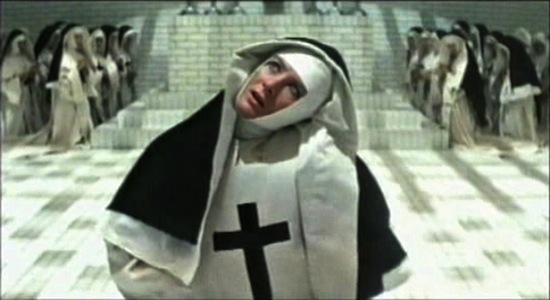
It was Ken Russell, another too-often forgotten visionary, who invited Jarman to design the sets for his manic reworking of Aldous Huxley’s The Devils of Loudon. In this historical tale of manic religious fervour and possession in 17th Century France, Russell can be found at his most Rabelaisian, throwing everything at the wall with anti-institutional glee. Jarman for his part sculpted supremely disorientating art deco interventions, immediately foregrounding his distinctive style – the purist, symmetrical modernist whites worked perfectly with the on-screen grotesquery to defamiliarise any sense of reality. It is this bending of time that was to become prominent both visually and structurally in later films.
In the Shadow of the Sun
…Sun belongs to a wealth of sensory Super 8 vignettes filmed by Jarman in the late 70s. It’s a film of incredibly eerie ambience, soundtracked by Throbbing Gristle at their most majestically droney. As bleached images of Avebury flow past figures carrying mirrors or wearing skull masks, it’s impossible not to surrender to its occult drift. This film peaks behind England’s Hidden Reverse (as David Keenan would come to call it). It shows an obsessional, Paganistic love of the English countryside – a way of finding mechanisms to let the past spill into the now. This is pure visual poetry. Jarman never stopped filming in Super 8, even decades after it had lost any cachet of cool, and his vast archives offered up potent images when health or funding issues impinged on his ability to get other projects off the ground.
War Requiem
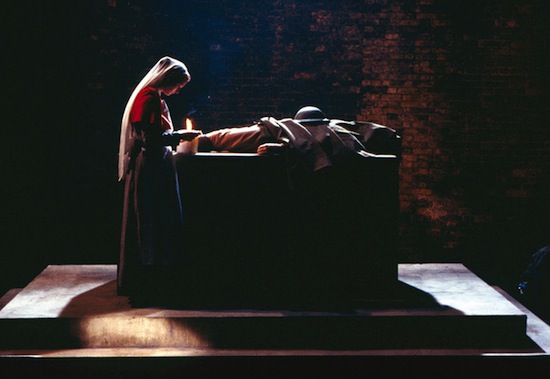
The opening scenes find a camera placed at an oblique angle, taking in a blue sky and an abandoned, boarded-up hospital. Emerging into view is a frail man in a wheelchair (mesmerisingly recognisable, this is Laurence Olivier in his final performance) and his nurse (Tilda Swinton). There is no sound to begin with, which is eerily disorientating, until Olivier’s voice, cloaked in deep reverb, starts reading Wilfred Owen’s Strange Meeting. The older man delivering the poetry of the young man who never survived the war makes for an experience that is both heartbreaking and disturbing. Jarring war footage drenched in coloured filters abruptly cuts the scene and it’s impossible not to be devastated when Olivier fumbles an old picture of what we can assume to be a past lover in a nurse’s uniform. This is merely the prologue to a succession of staged pieces set to the music of Benjamin Britten’s War Requiem, which itself was inspired by and features passages of Owen’s war poetry interspersed between traditional Latin texts. The tendency to interpret this as a kind of music video entirely misses the intentions behind it. The lineage it belongs to reveals of Jarman’s motivations and inheritance: this is really a piece of Wagnerian gesamtkunstwerk – a pitch at total art that incorporates sound, vision and poetry. It’s similar in nature to Kenneth Anger’s Inauguration of the Pleasure Dome, an esoteric carnival set to a mass by Janacek, and, most tellingly, Powell and Pressburger’s Tales of Hoffmann, their triumphant conclusion to the work started in The Red Shoes.
The Pet Shop Boys Tour 1989
This drive toward total art leads back to his original work in set design, so it was no surprise to find Jarman working with musicians outside of cinema. He produced background films and designed the spectacular theatrics behind the Pet Shop Boys’ first ever tour, something they had vowed never to do unless it could be done properly. The end result was akin to something like Busby Berkeley attempting to recreate a musical by Noel Coward in the style of Salvador Dali – a riotous explosion of day-glo which was equal parts pop and austerity. Jarman also filmed the video for ‘It’s A Sin’, once remarking that it was the best thing he ever did.
Modern Nature & Derek Jarman’s Garden
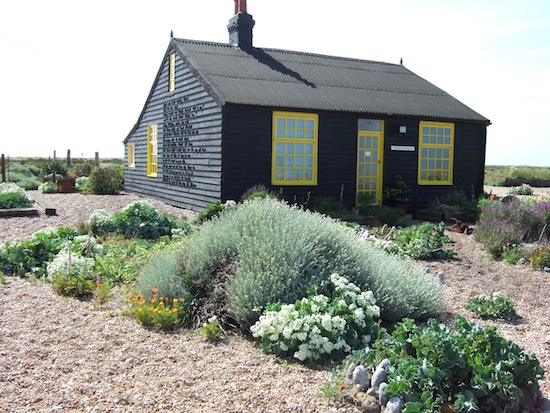
Jarman published a lot of written work, all of it worth exploring, but Modern Nature marked a structural and emotional turning point in his writings. In previous writings Jarman could be defiantly in-your-face (At Your Own Risk) and employ collage-like tendencies (arranging entries in a non-linear fashion in his journals for the making of The Last of England), but Modern Nature ploughs two furrows at once – it’s both an autobiographical reminiscence and a gardening manual. These diaries were written in the wake of his HIV diagnosis and the subsequent move to Dungeness. The only real certainty about the disease at the time was that it was terminal and that it carried a massive weight of social revulsion, although this was hardly something Jarman wasn’t used to. So he looks back over his life with fondness and affection but also (unsurprisingly) with heavy lament. especially at his self-imposed (relative) exile. The other strand in the narrative is the creation of his garden at Prospect Cottage in the shadow of the Dungeness B nuclear power station. His knowledge of gardening is vast and, without exaggeration, half of the book reads as a thorough (if slightly surreal) gardening manual.
He brought the house in 1986 and over the next eight years transformed his garden space in this genuinely bizarre landscape into a thing of unique and astounding beauty. Comprising found objects from the shingle beach and plants that would withstand the relentless spray and wind, Prospect Cottage has become his most famous work, visited by millions. It resembles something like an Yves Tanguy painting come to life, both blending in with its surroundings and remaining apart from them. The garden became prominent in all his work from its inception, and was the foil for all his anxieties and pain as well as a reflection of his relentless creative drive and joy in living.
Blue
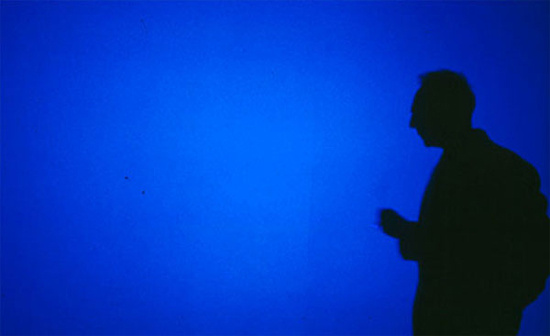
For those that had never liked Jarman, Blue was the final straw. Less outrage, scorn and derision has been piled on political lunatics who creatively build dull mythologies in an effort to invade oil-bearing countries illegally. However, in a huge coup, Blue was broadcast simultaneously on Radio 3 and Channel 4 – an unprecedented move, especially for something so ‘out’ and moving even closer to the synaesthesia quintessential to his work. Visually, Blue is simply a striking cobalt blue screen; its aural narrative features sound and music by long-term collaborator Simon Fisher Turner, Durutti Column and Coil amongst others, and readings and narration by Swinton, Nigel Terry, Quentin Oliver and Jarman himself. The visual aspect is as such due to this being all Jarman could see after his crippling illness robbed him almost completely of his sight. The narrative dwells heavily on mortality, as you might expect, but never veers into sentimentality, as Jarman seemingly never did himself. The screen as neon void also becomes something of a misnomer – surrender to the film and you’ll soon suffer your own hallucinations, as your mind’s eye creates its own visual signifiers.
Jarman would die within a year of its release. It’s heartbreaking to watch this man whither and surge and then whither again. It’s almost unbearable to see someone of such energy and fire and vision suffer so terribly and so honestly and never let up for a minute.
An astonishing polymath and a singular voice, Jarman represented a hidden strand of art, a radicalism unique to the English landscape, that’s inherently sensitive to the weirdness that seeps from the city sprawl and haunted countryside. He had the sensibilities of a William Blake collapsing temporal boundaries between past and present. He was entirely in everybody’s face about his sexuality and told the truth about AIDS when there was so much brutal misinformation and when many others remained silent in service to their careers. He had an opinion on pretty much everything and was extraordinarily happy to voice it, which wouldn’t always make him an easy person to deal with. That these opinions were so often anathema to the ruling order of the day makes it an achievement in itself that he managed to be heard at all. But he’s not remembered strongly enough and we need this documentary; we need to keep his spirit alive because, culturally, people like Jarman are needed now more than ever.
And fade out to blue….
For information and tickets on the BFI’s Derek Jarman season. please visit their website here

